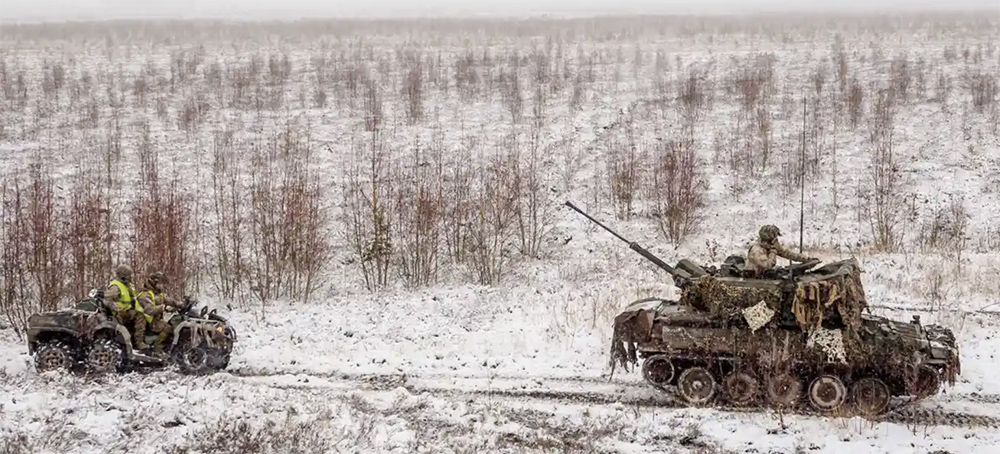NATO Reinforces Eastern Borders as Ukraine Tensions Mount
Daniel Boffey and Andrew Roth Guardian UK Soldiers taking part in NATO's annual Winter Shield military exercise in Adazi, Latvia, in November. (photo: Gints Ivuskans/AFP/Getty Images)
24 January 22
Soldiers taking part in NATO's annual Winter Shield military exercise in Adazi, Latvia, in November. (photo: Gints Ivuskans/AFP/Getty Images)
24 January 22
ALSO SEE: As Threat of Russian Invasion of Ukraine Looms,
US Considers Sending Troops to the Region
Stoltenberg says ‘deteriorating security situation’ has led Nato allies to ready frigates, fighter jets and troops for ‘collective defence’
Jens Stoltenberg said the “deteriorating security situation” had led Nato allies to ready frigates, fighter jets and troops for their “collective defence”.
The US administration was also ready to increase its military presence in eastern Europe, Nato’s chief, a former prime minister of Norway, warned in a statement that appeared designed to further raise the stakes for the Kremlin.
“I welcome allies contributing additional forces to Nato,” Stoltenberg said. “Nato will continue to take all necessary measures to protect and defend all allies, including by reinforcing the eastern part of the alliance. We will always respond to any deterioration of our security environment, including through strengthening our collective defence.”
The announcement was condemned as western “hysteria” by the Kremlin. “We see statements by the North Atlantic Alliance about reinforcement, pulling forces and resources to the eastern flank. All this leads to the fact that tensions are growing,” Kremlin spokesman Dmitry Peskov said. “This is not happening because of what we, Russia, are doing. This is all happening because of what Nato and the US are doing and due to the information they are spreading.”
Russia’s deputy foreign minister, Alexander Grushko, condemned the deployments, saying that the military alliance was “demonising Russia” in order to “justify military activity on [Nato’s] eastern flank”.
“The language of Nato is the language of threats and military pressure,” he said in remarks published by Russian media. “This is nothing new.”
The developments came as the White House and Downing Street said they had started withdrawing diplomats’ families from Ukraine, and EU foreign ministers gathered to discuss the escalating crisis with the US secretary of state, Antony Blinken.
Blinken is to brief the ministers by video link on his talks last week with the Russian foreign minister, Sergei Lavrov.
More than 100,000 Russian troops and heavy weapons have been mobilised on the Ukrainian border.
The EU’s foreign policy chief, Josep Borrell, said the bloc would consider removing its staff after the talks with Blinken but that he was not yet aware of an urgent need.
The new Nato military capability announced for the east includes Denmark’s deployment of a frigate to the Baltic Sea and four F-16 fighter jets to Lithuania.
Spain has said it is sending ships to join Nato naval forces and is considering sending fighter jets to Bulgaria. Emmanuel Macron has expressed his government’s readiness to send French troops to Romania under Nato command.
Nato increased its presence within the territory of its eastern member states in response to Russia’s annexation of Crimea in 2014. There are currently four multinational battlegroups in Estonia, Latvia, Lithuania and Poland, led by the UK, Canada, Germany and the US.
At their meeting in Brussels, EU ministers reiterated their warning of a severe economic price to be paid by Russia should it invade Ukraine, after a wobble in Berlin.
Germany’s navy chief, Kay-Achim Schönbach, resigned after it emerged that he has said that Vladimir Putin deserved respect.
Gabrielius Landsbergis, Lithuania’s foreign minister, said the new German government was in a “difficult situation” having started just “a month ago”.
But he warned that the EU and the US needed to show a unified front. “We are convinced that real war is a likely possibility,” he said. “The sanctions have to be unbearable.”
In a joint statement, the EU ministers said Russia’s mobilisation was a threat to peace and stability on the continent of Europe. “Notions of ‘spheres of influence’ have no place in the 21st century,” the 27 member states said.
Arriving in Brussels, Ireland’s foreign minister, Simon Coveney, had said he would inform his counterparts that Russia planned to hold war games 240km (150 miles) off Ireland’s coast, within international waters and the country’s exclusive economic zone.
He said: “We don’t have a power to prevent this happening but certainly I’ve made it clear to the Russian ambassador in Ireland that it’s not welcome.
“This isn’t a time to increase military activity and tension in the context of what’s happening with and in Ukraine. The fact that they are choosing to do it on the western borders, if you like, of the EU, off the Irish coast, is something that in our view is simply not welcome and not wanted right now, particularly in the coming weeks.”
Russia continued preparations for sweeping naval exercises on Monday as the Baltic Fleet announced that two corvettes had set sail to join in the military drills.
The Kremlin has also dispatched six amphibious landing ships to the Mediterranean Sea as part of the exercises, which will include 140 ships and more than 10,000 Russian troops.
Russia is also set to hold joint military drills in Belarus in February. The Belarusian leader, Alexander Lukashenko, said on Monday he would deploy a “whole contingent of the army” to the border with Ukraine, alleging that “Ukrainians have begun to gather troops [there]. I don’t understand why.”
Ursula von der Leyen, president of the European commission, announced that the EU would provide €1.2billion in loans and grants to Ukraine to help cover the financial cost of the conflict.
She said: “As ever, the EU stands by Ukraine in these difficult circumstances. We are firm in our resolve.”



